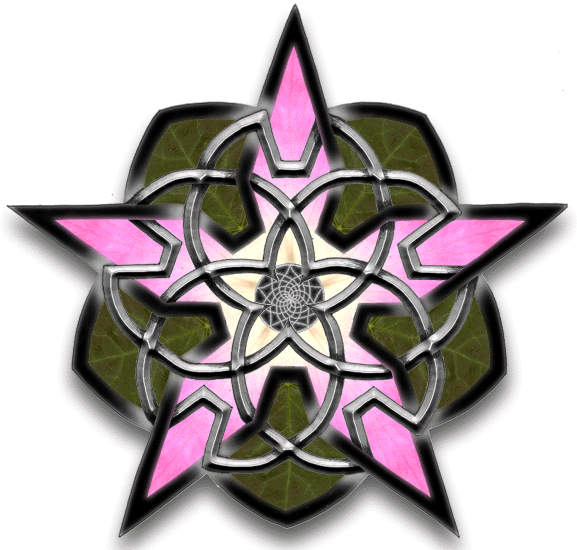- Lesson One: The Number One
- ... in Geometry
- ... in Nature
- ... in Culture
- "Uroboros" (related artwork by the author)
- "Creation" (related artwork by the author)
- Lesson Two: The Square Root of Two
- ... in Geometry
- ... in Nature, Part 1
- ... in Nature, Part 2
- ... in Culture, Part 1
- ... in Culture, Part 2
- "Duality" (related artwork by the author)
- Lesson Three: The Square Root of Three
- ... in Geometry
- ... in Nature
- ... in Culture
- "Vesica" (related artwork by the author)
- Lesson Four: Phi, or the Golden Proportion
- ... Intro, Part 2
- ... Intro, Part 3
- ... in Geometry
- ... in Nature
- ... in Nature, Part 2
- ... in Culture
- "The Flower of Phi" (related artwork by the author)
- Lesson Five: The Five Perfect Solids
- ... Intro, Part 2
- ... The Tetrahedron
- ... The Octahedron
- ... The Cube
- ... The Icosahedron
- ... The Dodecahedron
AUTHOR'S NOTE, 1/2022: I created this artwork almost 25 years ago at the start of my career as a graphic designer. Visually the work has certainly not withstood the test of time and frankly is a bit embarassing to me personally, but I am including it regardless as I believe the associated notes can still assist the reader in understanding how one can interpret and utilize the principles of sacred geometry in the creation of visual artwork.
 Original artwork created by A. O'Connor for Nature's Word using pen, ink, and Adobe Photoshop 5.0.
Original artwork created by A. O'Connor for Nature's Word using pen, ink, and Adobe Photoshop 5.0.Clicking here will launch a new browser tab with a large version of the artwork. In this way, the observer may jump back and forth between text and image simply by clicking on the separate windows.
The symbolism of the piece:
When creating this piece I had two major goals in mind: first, to create a visual image that adheared very directly to the proportions of Phi, and second, to represent that image as a sort of knot-work flower. After having worked with the geometry of the pentagon, it was clear that it would be possible to create a matrix that would grant huge possibilities for creating a design that would appeal to the eye, yet represent Phi in all ways. It seemed only natural to attempt to portray the final image as a plant or flower form, as many flowers desplay five-fold symmetry in their flowers.
Most of the symbolism is self-apparent in this piece - obviously I have used leaf and flower petal textures to fill the negative space between the lines of the artwork in order to generate the appearence of a flower. In the center of the flower we find a geometric counter-spiraling pattern, representing the seed base that we find at the center of many real flowers. The counter-spiral pattern contains ten spirals spiraling in each direction, with the clockwise spiraling lines rotating 222 degrees ((1 divided by Phi) times 360), and the counter clockwise spiraling lines rotating 136 degrees ((1 divided by (Phi to the second power)) times 360)
As opposed to using the treatment of the lines themselves for any sort of symbolic value, I instead chose to simply leave them plain and bold. This decision resulted from the urge to leave their direct adhearence to the pentagonal grid as their most major statement. The pentagonal grid on which this piece is based can be viewed below the piece itself by clicking the image icon above, and then scrolling down.
Creative Process of the Piece:
I began this piece by generating the pentagonal grid on which it is based with pencil, compass and straightedge on paper. I then used the major intersections of lines on the grid to generate the basic weave pattern that can be seen in the final piece. After initially creating this pattern with pencil, I went back over it with ink, and added shading near the "woven" intersections to give a sense of depth to the weave.
I then scanned in this pen and ink creation and began working with the design in Adobe PhotoShop 5.0.
After working for some time with trying to create realistic leaf and flower petal textures, I decided instead to simply scan in real leaves and flower petals, and fill the negative space in the design with those scanned images. I picked and scanned in about five leaves and five petals, and picked one of each to use in the design.
I treated the linework in PhotoShop by running an Inner Bevel filter on the curving line pattern, and an Antimatter filter on the pentagram pattern.
I generated the counter-spiraling pattern by running a twirl pattern on a basic pattern of ten regularly radiating lines. When I had created both clockwise and counter clockwise spirals, I overlaid them on one another and ran an Antimatter filter on the conjoined counter-spiraling pattern.
Finally, I added a dropshadow effect using a Dropshadow filter, simply to bring the completed image off the page a bit, in hopes that this would add to the overall realism of the piece.


